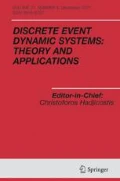Abstract
Timed automata are an important model for specifying and analyzing real-time systems. The main analysis performed on timed automata is the reachability analysis. In this paper we show that the standard approach for performing reachability analysis is not correct when the clocks drift even by a very small amount. Our formulation of the reachability problem for timed automata is as follows: we define the set R *(T,Z 0)=∩∈>0 Reach(T∈, Z 0 where T∈ is obtained from timed automaton T by allowing an ∈ drift in the clocks. R *(T,Z 0) is the set of states which can be reached in the timed automatonT from the initial states in Z0 when the clocks drift by an infinitesimally small amount. We present an algorithm for computing R *(T,Z 0)and provide a proof of its correctness. We show that R *(T,Z 0)is robust with respect to various types of modeling errors. To prove the correctness of our algorithm, we need to understand the dynamics of timed automata—in particular, the structure of the limit cycles of timed automata.
Similar content being viewed by others
References
Alur, R., and Dill, D. 1990. Automata for modeling real-time systems. Proc. 17th ICALP. LNCS 443, Springer-Verlag.
Alur, R., et al. 1995. The algorithmic analysis of hybrid systems. Theoretical Computer Science.
Alur, R., Itai, A., Kurshan, R., and Yannakakis, M. 1995. Timing verification by successive approximation. Information and Computation 118: 142–157.
Alur, R., and Kurshan, R. 1996. Timing analysis in COSPAN. Hybrid Systems III. LNCS 1066, Springer-Verlag.
Bengtsson, J., Larsen, K. G., Larsson, F., Pettersson, P., and Yi, W. 1996. UppAal: a tool-suite for automatic verification of real-time systems. Hybrid Systems III. LNCS 1066, Springer-Verlag.
Cormen, T. H., Leiserson, C. E., and Rivest, R. L. 1990. Introduction to Algorithms. MIT Press.
Courcoubetis, C., and Yannakakis, M. 1992. Minimum and maximum delay problems in real-time systems. Formal Methods in System Design 1: 385-415.
Daws, C., Olivero, A., Tripakis, S., and Yovine, S. 1996. The tool Kronos. Hybrid Systems III. LNCS 1066, Springer-Verlag.
Dill, D. 1989. Timing assumptions and verification of finite state concurrent systems. Automatic Verification Methods for Finite-State Systems. LNCS 407, Springer-Verlag.
Gupta, V., Henzinger, T., and Jagadeesan, R. 1997. Robust timed automata. First International Workshop on Hybrid and Real-time Systems (HART 1997). LNCS 1201, Springer-Verlag.
Henzinger, T., Ho, P.-H., and Wong-Toi, H. 1997. HyTech: A model checker for hybrid systems. Computer Aided Verification. LNCS 1254, Springer-Verlag.
Henzinger, T., Nicollin, X., Sifakis, J., and Yovine, S. 1992. Symbolic model-checking for real-time systems. Proc. 7th IEEE Symp. on Logic in Computer Science.
Hirsh, M. W., and Smale, S. 1974. Differential Equations, Dynamical Systems, and Linear Algebra. Academic Press, Inc.
Puri, A., and Varaiya, P. 1996. Decidable hybrid systems. Computer and Mathematical Modeling 23: 191-202.
Puri, A. 1995. Theory of hybrid systems and discrete event systems. Ph.D. thesis, University of California, Berkeley.
Yannakakis, M., and Lee, D. 1993. An efficient algorithm for minimizing real-time transition systems. Computer Aided Verification. Springer-Verlag.
Rights and permissions
About this article
Cite this article
Puri, A. Dynamical Properties of Timed Automata. Discrete Event Dynamic Systems 10, 87–113 (2000). https://doi.org/10.1023/A:1008387132377
Issue Date:
DOI: https://doi.org/10.1023/A:1008387132377




